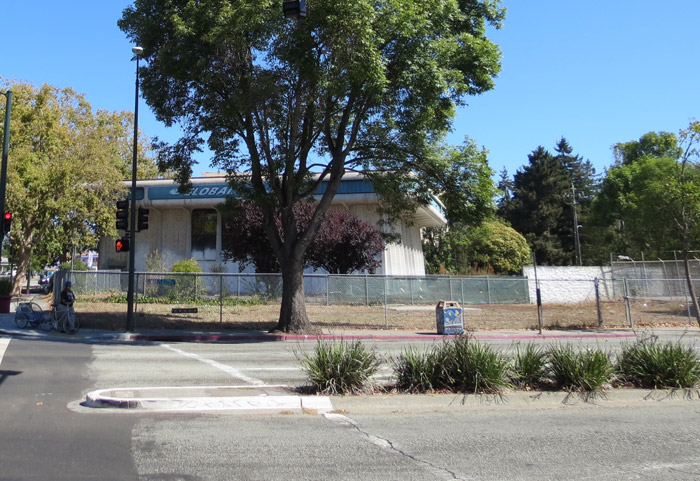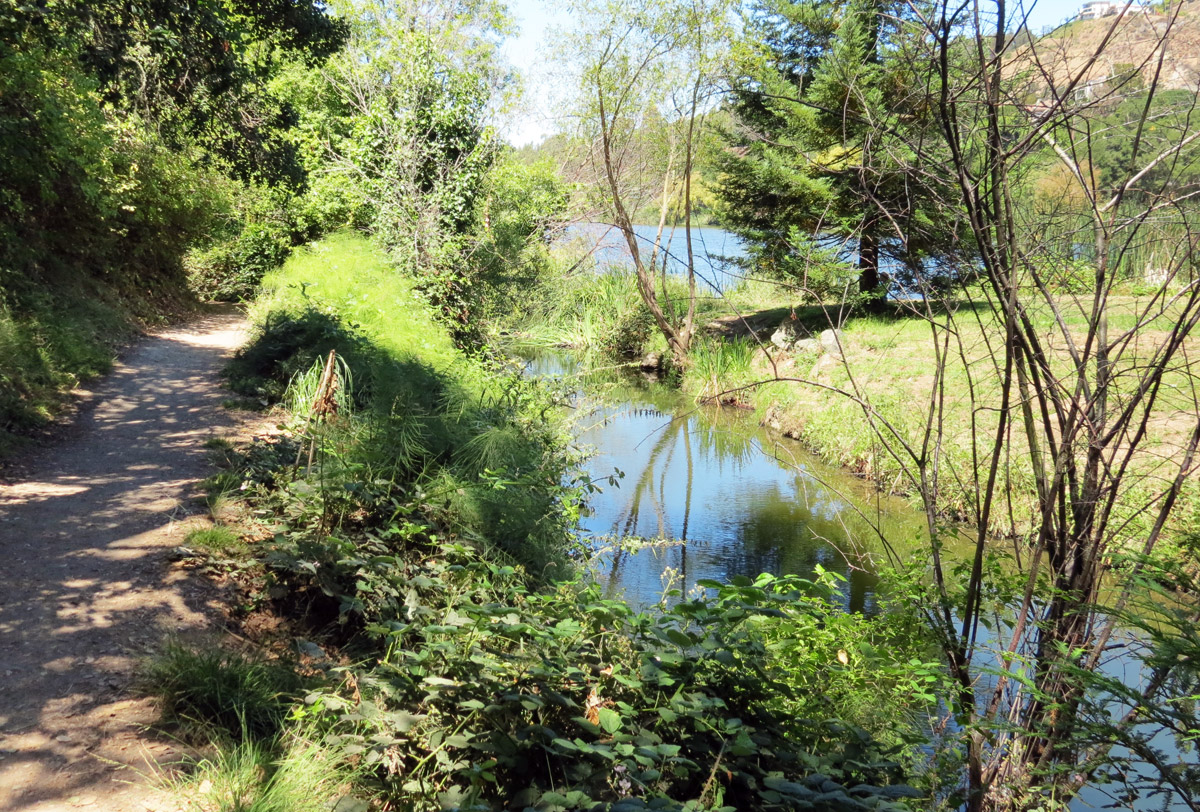W
hen Joan Marie Wood moved to Oakland’s Temescal district in 1983, the neighborhood’s most recognizable landmark was an X-rated movie theater called The Pussycat. Since the theater’s demolition in the 1990s, the site at 51st and Telegraph has sat largely vacant: a Christmas tree or pumpkin lot during the holidays, an occasional outdoor movie screening space, but mostly just a patch of dead grass surrounded by chain-link fence.
But Wood knows something about the site many newcomers to the area may not: 15 feet below ground is the hidden resource of Temescal Creek, a landmark worthy of neighborhood pride — if only more people knew it was there.
With a developer now eyeing the site for a retail and residential project, creek advocates like Wood see a chance to help the creek flow back into public consciousness. “There’s a fantastic, rich history about the creek that could be told,” she says. “We would like to see that integrated into the site design.”

L
ike many urban streams in the Bay Area, Temescal Creek was buried during the intense urban development of the 1960s and ‘70s. It now flows through concrete culverts from Lake Temescal in the Oakland hills, through the flats of Oakland and Emeryville, into San Francisco Bay—out of sight and largely out of mind.
Before its burial, the creek had long been a locus of human activity. A Huchiun village was less than a block from the proposed modern development, and the Native Californians built large sweat lodges beside the creek. Early Spanish settlers referred to the lodges by the Aztec word temescalli, which later gave the creek its name.
Spanish landowner Vicente Peralta chose a spot near the creek as an ideal setting for his adobe house and orchard, and in the following decades, the village of Temescal grew around his hacienda. In 1868, the creek provided Oakland’s first municipal water source when mining hydrologist Anthony Chabot dammed it to form Lake Temescal. Soon after, a green space known as Humboldt Park was built at the present-day development site, providing a popular place for locals to stroll, picnic, and fish.
But Temescal Creek’s appeal would eventually be its undoing. As Temescal grew from village to town to big-city neighborhood, houses were built right up against the creek edge. Neighbors dumped trash and other pollutants into the stream, and flooding during winter rains became an issue. “Flooding is really a human problem, not a natural problem,” says Kristen Van Dam, a riparian ecologist and former project manager for the Urban Creeks Council. Building properties right up to the creek edge, she says, “limits the creek’s water-carrying capacity and puts homes and other resources in the path of the creek’s natural floodplain.”
A major flood in 1962 helped cement a growing view among some residents and city officials that the creek was a nuisance. Alameda County Flood Control announced a plan to culvert the creek, a process that began with the construction the section of Highway 24 between the Caldecott Tunnel and downtown Oakland. A section of the creek from Lake Temescal to Hardy Park in Rockridge was undergrounded.
Then the flooding got worse. “The hydrology of the creek was totally compromised by the freeway,” says Bruce Douglas, co-founder of Friends of Temescal Creek (FoTC). The natural creek bed, he says, was able to absorb and release water slowly into the ground, while the concrete tunnel that replaced it allowed rain to rush downstream at high speed.
Undeterred, the county used the flooding to justify plans to culvert two more long stretches of the creek, including the portion that ran through Temescal. A small contingent of neighbors in Temescal and Rockridge fought hard to keep the creek open, arguing for its value as a place where kids played, community members gathered, and animals such as fish, birds, and amphibians lived. But the argument against keeping the creek won out. “Many neighbors saw it as a blight, a conduit of crime and trash,” Douglas says, “something to be rid of.”
Resistance did at least win a three-block-long strip of land above the buried creek, which was set aside for public use. Later efforts by FoTC, another group called Friends of the Temescal-Rockridge Greenbelt (FROG), and more than 1,300 local volunteers transformed the barren strip into the Rockridge-Temescal Greenbelt, a public park with two playgrounds and a meandering path through native trees. The park also includes a “reconstituted creek,” filled by water pumped up from the culvert below. The pathway is lined with artistic and interpretive design elements referencing the history and ecology of the creek.
The faux creek was a compromise for those who fought to save the real Temescal Creek. But as local historian and FoTC member Jeff Norman writes in his book Temescal Legacies, “the small, flowing stream can still evoke a magical sense of the natural forces that surround us. In an intensely urban setting, where 50,000 people now share the Temescal watershed, that kind of experience, however subtle is precious.”
For Temescal Creek advocates, a similar sentiment informs their hopes for the site at 51st and Telegraph. Members of FoTC and FROG say the developer, the Nautilus Group, has been receptive to their requests to extend the Rockridge-Temescal Greenbelt through the center of the development and to include information about the creek. Brian Caruso, a project executive with Nautilus, says the current development plans include an extension of the Greenbelt, but there’s been no decision about whether or not to include a creek-like water feature. “To the extent that these design features, together with educational components, are feasible, they will be part of the design,” he says.
For FoTC, the dream scenario would be to “daylight” Temescal Creek at 51st and Telegraph and restore its natural creek bed, but Caruso says, “despite being an amazing idea, it is not feasible.”
The greenbelt extension would connect the trendy Temescal shopping district with the rest of the park, Wood says, providing an opportunity to spread knowledge about the creek. “A lot of people are moving into the area that have no idea there’s a buried creek here,” she says. “Part of being able to make different decisions in the future rests on building awareness in the population.”
When Wood first arrived in the neighborhood, she says, she had no clue a creek ran through the area. When she found out, she joined FoTC and become involved in water quality testing and participated in FoTC-organized creek walks that followed the creek’s tributaries to their sources. “My hope is that we let the creek help us shift away from seeing every aspect of land as usable in the human economy,” she says, “and work toward a kind of collaborative environment where creeks have rights to exist and aren’t built on top of. That’s my dream.”




-300x172.jpg)